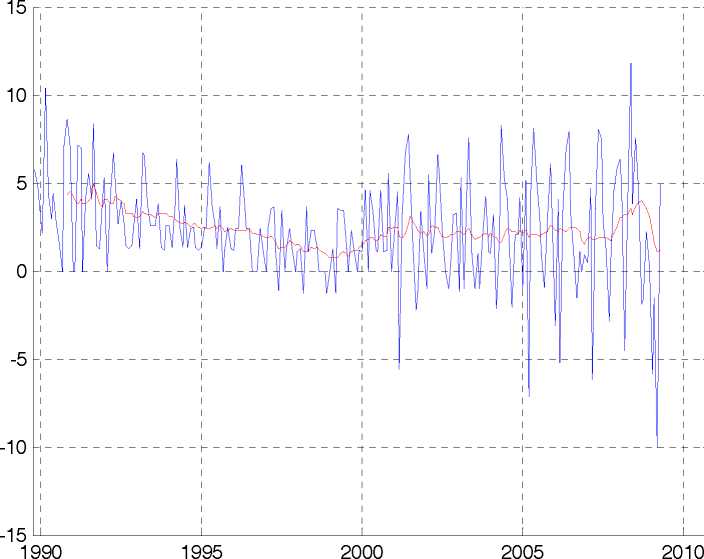3. Empirical Analysis
3.1 Data Description
Our preferred measure of inflation is the monthly rate of change of the seasonally
unadjusted Harmonised Index of Consumer Prices (HICP) for the Eurozone as a
whole.1 The sample period is 1980:m1 - 2009:m2. Chart 1 below plots this series
from 1990 onwards together with the corresponding year-on-year growth rate. Visual
inspection suggests declining inflation and relatively subdued variability in the run-up
to EMU and stable inflation afterwards with increased variability, particularly so
towards the end of the sample.
Chart 1. EMU Inflation

Chart 2 shows the seasonally unadjusted monthly unemployment rate. The series
exhibits a cyclical pattern and is clearly linked to output developments over the same
period. Finally Chart 3 contains the scatter plot of inflation against the unemployment
rate. Consistently with the expectations-augmented Phillips curve framework (Phelps,
1967, and Friedman, 1968), it suggests that there is an inverse relationship between
inflation and the unemployment rate and that a downward shift might have occurred
at the start of EMU. Further, the curve appears to be flatter in the euro years. 2
1 “Euro area (changing composition) - HICP - Overall index, Monthly Index, Eurostat, neither
seasonally nor working day adjusted”. Eurostat code: VAL.IDX05.EMU.00. This series is available
from January 1990, and has been extended backwards using a weighted average of the growth rates of
the corresponding national series for France, Germany, Italy and Spain.
2 “Euro area (changing composition) - Standardised unemployment rate, Total (all ages), Total (male &
female), Eurostat, neither seasonally or working day adjusted, percentage of civilian workforce”. The
series is available from January 1993, with Eurostat code:
More intriguing information
1. Endogenous Heterogeneity in Strategic Models: Symmetry-breaking via Strategic Substitutes and Nonconcavities2. An Efficient Circulant MIMO Equalizer for CDMA Downlink: Algorithm and VLSI Architecture
3. The name is absent
4. The name is absent
5. Synthesis and biological activity of α-galactosyl ceramide KRN7000 and galactosyl (α1→2) galactosyl ceramide
6. Strategic Policy Options to Improve Irrigation Water Allocation Efficiency: Analysis on Egypt and Morocco
7. Developing vocational practice in the jewelry sector through the incubation of a new ‘project-object’
8. The open method of co-ordination: Some remarks regarding old-age security within an enlarged European Union
9. The Effects of Attendance on Academic Performance: Panel Data Evidence for Introductory Microeconomics
10. Categorial Grammar and Discourse